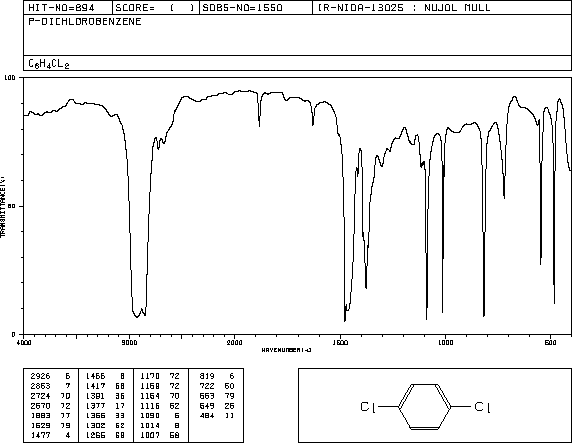The aromatic molecule used in this study was P-dichlorobenzene. Multiple calculations were done on p-dichlorobenzene and displayed below.
P-dichlorobenze geometry optimizations of DZV was chosen as the "best" calculations compared to experimental data because the total amount of energy points the geometry optimization took to converge was the least amount of data points(steps)
P-dichlorobenzene(DZV) structure geometry optimized
|
|
Bond Lengths of Aromatic Molecule
P-dichlorobenzene(DZV) bond lengths.
Reference data bond lengths where A=Angstrom, C=C = 1.399A, C-H-=1.101A, C-Cl = 1.798A3
Button below display bond lengths of molecule
|
|
| DZV bonds |
DZV bond lengths |
| C=C |
1.39A |
| C-H |
1.07A |
| C-Cl |
1.8A |
Bond Angles of Aromatic Molecule
P-dichlorobenzene(DZV) bond angles displayed in the box below. Where H1 does not have a carbon bonded to Cl and H2 has a carbon bonded to Cl.
|
|
| Bonded Atoms |
Bond Angle in Degrees |
| H1-C=C |
120.2 |
| H2-C=C |
1120.7 |
| C=C=C |
119.1 |
| Cl-C=C |
119.1 |
Molecular Orbitals of p-dichlorobenzene HOMO and LUMO
P-dichlorobenzene(DZV) HOMO in the box below. Highest occuiped molecular orbital HOMO (1π orbital)
|
|
P-dichlorobenzene(DZV) LUMO in the box below. Lowest occupied molecular orbital LUMO (2π orbital)
|
|
Partial atomic charges of each atom in the aromatic molecule
P-dichlorobenzene(DZV) partial atomic charges of each individual atom.
|
|
Electrostatic potential of molecule
P-dichlorobenzene(DZV) electrostatic potential display. Red color denotes regions of realtive negative potential and blue regions of realtive positive potential.
|
|
Dipole moments of molecule
Three dipole moments are displayed with the DZV (best), 6-31G, 6-21G respectively
| Calculated Dipole Moments |
Experimental Dipole
Moments4 |
| 0.000324 |
0 |
| 0.000698 |
0 |
| 0.000752 |
0 |
Vibrational Frequency of P-dichlorobenzene
IR spectrum of p-dichlorobenzene is connected to link below

Reference link from Spectral Database for Organic Compounds SDBS
http://riodb01.ibase.aist.go.jp/sdbs/cgi-bin/direct_frame_top.cgi3
Aromatic ring vibration frequency occurs at 1535.8601^cm-1
Aromatic ring vibration can be observed by button below.
|
|
C-Cl vibration frequency occurs at 544.42004^cm-1
C-Cl vibration can be observed by button below
|
|
C-H asymmetric vibration frequency occurs at 3433.85^cm-1
C-H asymmetric vibration can be observed by button below
|
|
C-H symmetric vibration frequency occurs at 3451.25^cm-1
C-H symmetric vibration can be observed by button below
|
|
UV-Vis peak positions
CIS Transition energies were found for DZV ab initio levels. The highest energy from ground to excited were 8.26ev (ground to excited state 5) and 8.38ev (ground to excited state 6). The oscillator strength (greatest intensity) was 1.617370 and 1.051165, with wavelength 150nm and 148nm respectively. The wavelengths were compared to the experimental values of a UV-Vis spectrum. Link to experimental values. UV-Vis Spectrum2
These values did not correspond to experimental values (210nm and greater)
References
(1) Lide, D. R. CRC Handbook of Chemistry and Physics; CRC Press: Boca Raton, 1992.
(2) "SpectraSchool." RCS Advancing the Chemical Sciences. University of Leicester, n.d. Web. 2 Mar 2012. <http://www.le.ac.uk/spectraschool/>.
(3) "Spectral Database for Organic Compounds." Sdbs information. (c) National Institute of Advanced Industrial Sci, 2011. Web. 2 Mar 2012. <http://riodb01.ibase.aist.go.jp/sdbs/cgi-bin/direct_frame_top.cgi>.
(4) An Apparatus for Refined Thermal Analysis Exemplified by a Study of the System p-Dichlorobenzene—p-Dibromobenzene—p- Chlorobromobenzene
A. N. Campbell and L. A. Prodan
Journal of the American Chemical Society 1948 70 (2), 553-561
Page
skeleton and JavaScript generated by export to web function
using Jmol 12.2.RC3
2011-08-06 04:51 on Feb 28, 2012.
